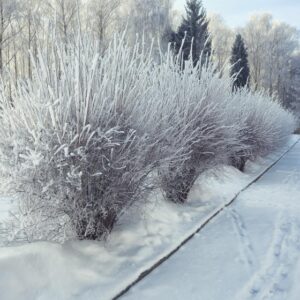If you thought you wouldn’t have to think about your trees until spring — much less care for them — you wouldn’t be alone. However, trees should be nurtured and protected year-round to make sure that they stay healthy.
Step 1: Keep Trees Clear of Snow
The winter is hard on trees, even those that are accustomed to cold climates. Stress caused by cold, drought, pests and branch breakage can take its toll. While you can’t do much about the weather and icy temperatures, you can take steps to lessen their impact.
After a heavy snow, brave the cold and do your best to remove as much snow as possible from your trees’ branches. Excess snow can cause branches to bend — which can cause damage — as well as break. Too much snow sometimes can even make the trees themselves bend and break. Remove snow using a broom or a similar tool to gently remove snow from tree branches. Use a broom in an upward, sweeping motion. You can also shake or tap tree trunks to remove snow, however, don’t shake the branches — this may cause them to break. If the snow is frozen on the branch and will not brush off easily, it is best to let it melt naturally to avoid damage to the tree or shrub.
Helpful Tip
Remove snow from tree branches as soon as possible; as the longer the snow remains on your trees’ branches, the more apt it is to freeze on the tree and remain there to do more damage.
If tree limbs break or sag under the weight of ice or snow, it’s best to have them removed as soon as the weather permits. Hanging branches can be a danger to passing pedestrians. Also, the tree will be able to heal the wound better in spring if the wound has clean edges instead of ragged tears. Remove broken branches by hand, or if necessary, by using a hand saw or hatchet. Put all branches and plant material in yard refuse bags.
Step 2: Fight Winter Drought
Wind and a lack of liquid water can cause drought in the winter months. Once the ground freezes, tree roots can’t absorb any more water. While it might seem strange to water trees in cold weather, it should be done if you didn’t do it earlier in the fall, as tree roots often do not get enough moisture after the ground is frozen for an extended period of time. While often there isn’t much to be done about drought once winter really kicks in, on a milder day when the ground isn’t frozen, you can try watering around the base of trees.
Helpful Tip
Add a thick layer of mulch around tree bases in late fall and water them thoroughly then. The mulch helps the tree roots retain water, slows moisture loss and runoff and acts as a buffer between tree roots and frigid temperatures.
Step 3: Bundle Them Up
Your trees are unlike their counterparts in a forest or other wooded area in that they probably are unprotected and isolated in comparison. Trees in this situation should be sheltered and protected from the wind and cold by wrapping their trunks or covering them completely for a short time with tree blankets or other types of coverings. Younger trees are especially susceptible to the effects of the cold.
Protect tree bark from cracking by wrapping tree trunks with burlap strips. Wind them diagonally around the trunk, and secure the strips with twine.
Some trees may require complete coverage for short-periods when the cold is especially harsh. Using heavy sheets, blankets or cold weather blankets made specifically for this purpose can protect your trees. Drape the material over the tree you want to protect and secure it to the ground or around the trunk to prevent it from blowing or slipping off using twine. This should be done temporarily only when temperatures are at their most extreme.
Step 4: Keep Critters Away
The weather isn’t the only thing that trees contend with during winter. Squirrels, rabbits, mice and other animals, such as deer, can damage bark, limbs and leaves.
Place wire mesh or chicken wire around the base of the tree about 6″ from the tree like a fence to prevent most rodents from getting their teeth on the bark. You may want to apply a squirrel repellent to stop squirrels from climbing and damaging trees. Consult your local True Value expert for the best product for the job.
Step 5: Prune in Late Winter
Winter is a great time to prune most deciduous trees. Because they’re dormant in winter, fruit, flowering and shade trees can be pruned now. When pruning large limbs, always undercut first — cut from the bottom up, one-third of the way through the limb, then finish by cutting from the top. The undercut keeps the limb from splitting and breaking off, preventing damage to the trunk. Don’t cut flush to the trunk. It’s the collar or enlarged base of a branch that produces the hormones to help heal wounds, so it’s important to keep the collar intact.
Good job! By braving the chill and caring for your trees during the winter months, they will flourish and help your property look its best.
Project Shopping List
Here’s what you’ll need to complete this project successfully.
- Broom or similar tool
- Hand rake
- Hatchet
- Yard refuse bags
- Mulch
- Tree blankets
- Burlap strips
- Twine
- Wire mesh
- Chicken wire
- Pruners












